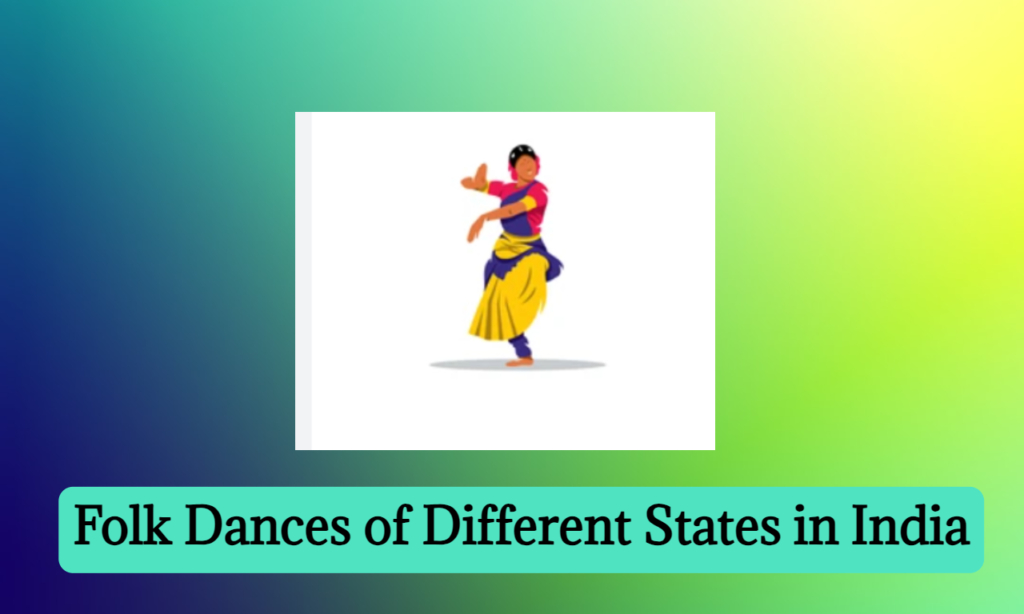Folk Dance: An Introduction
- A folk dance is a dance that reflects the life of the people of a specific country or region.
- All ethnic dances are not folk dances. for example, Ritual dances. Ritual dances are referred to as “religious dances” as they are performed for specific purposes.
- The terms “ethnic” and “traditional” are used when necessary to emphasize the cultural roots of the dance. In this way, almost all folk dances are ethnic.
- In some dances, like the polka, cross ethnic lines and even cross the line between “folk dance” and “ballroom dancing,” the ethnic differences are often significant enough to mention.
- Each state has its own folk dance. The folk dance also keeps the history of the people alive. Dances are ways in which a community celebrates a special event or an important date in time.
List of Folk Dances: State-Wise
Serial No. |
State |
Folk Dance |
| 1 | Andhra Pradesh | Kuchipudi, Vilasini Natyam, Andhra Natyam, Bhamakalpam, Veeranatyam, Dappu, Tappeta Gullu, Lambadi, Dhimsa, Kolattam, Butta Bommalu |
| 2 | Assam | Bihu, Bichhua, Natpuja, Maharas, Kaligopal, Bagurumba, Naga dance, Khel Gopal, Tabal Chongli, Canoe, Jhumura Hobjanai |
| 3 | Bihar | Jata-Jatin, Bakho-Bakhain, Panwariya, Sama Chakwa, Bidesia |
| 4 | Gujarat | Garba, Dandiya Raas, Tippani Juriun, Bhavai |
| 5 | Jammu and Kashmir | Rauf, Hikat, Mandjas, Kud Dandi Nach, Damali |
| 6 | Haryana | Jhumar, Phag, Daph, Dhamal, Loor, Gugga, Khor, Gagor |
| 7 | Himachal Pradesh | Jhora, Jhali, Chharhi, Dhaman, Chhapeli, Mahasu, Nati, Dangi |
| 8 | Karnataka | Yakshagana, Huttari, Suggi, Kunitha, Karga, Lambi |
| 9 | Kerala | Kathakali (Classical), Ottam Thulal, Mohiniattam, Kaikottikali |
| 10 | Maharashtra | Lavani, Nakata, Koli, Lezim, Gafa, Dahikala Dasavtar or Bohada |
| 11 | Odisha | Odissi (Classical), Savari, Ghumura, Paika, Munari, Chhau |
| 12 | West Bengal | Kathi, Gambhira, Dhali, Jatra, Baul, Marasia, Mahal, Keertan |
| 13 | Punjab | Bhangra, Giddha, Daff, Dhaman, Bhand, Naqual |
| 14 | Rajasthan | Ghumar, Chakri, Ganagor, Jhulan Leela, Jhuma, Suisini, Ghapal, Kalbelia |
| 15 | Tamil Nadu | Bharatanatyam, Kumi, Kolattam, Kavadi |
| 16 | Uttar Pradesh | Nautanki, Raslila, Kajri, Jhora, Chappeli, Jaita |
| 17 | Uttarakhand | Garhwali, Kumaoni, Kajari, Jhora, Raslila, Chappeli |
| 18 | Goa | Tarangamel, Koli, Dekhni, Fugdi, Shigmo, Ghode, Modni, Samayi nrutya, Jagar, Ranmale, Gonph, Tonnya mell |
| 19 | Madhya Pradesh | Jawara, Matki, Aada, Khada Nach, Phulpati, Grida Dance, Selalarki, Selabhadoni, Maanch |
| 20 | Chhattisgarh | Gaur Maria, Panthi, Raut Nacha, Pandwani, Vedamati, Kapalik, Bharthari Charit, Chandaini |
| 21 | Jharkhand | Alkap, Karma Munda, Agni, Jhumar, Janani Jhumar, Mardana Jhumar, Paika, Phagua,Hunta Dance, Mundari Dance, Sarhul, Barao, Jhitka, Danga, Domkach, Ghora Naach |
| 22 | Arunachal Pradesh | Buiya, Chalo, Wancho, Pasi Kongki, Ponung, Popir, Bardo Chham |
| 23 | Manipur | Dol Cholam, Thang Ta, Lai Haraoba, Pung Cholom, Khamba Thaibi, Nupa Dance, Raslila, Khubak Ishei, Lhou Sha |
| 24 | Meghalaya | Ka Shad Suk Mynsiem, Nongkrem, Laho |
| 25 | Mizoram | Cheraw Dance, Khuallam, Chailam, Sawlakin, Chawnglaizawn, Zangtalam, Par Lam, Sarlamkai/Solakia, Tlanglam |
| 26 | Nagaland | Rangma, Bamboo Dance, Zeliang, Nsuirolians, Gethinglim, Temangnetin, Hetaleulee |
| 27 | Tripura | Hojagiri, Lebang Boomani, Garia, Bijhu, Hai-Hak, Wangala, Welcome, Cheraw, Sangrai |
| 28 | Sikkim | Chu Faat Dance, Sikmari, Singhi Chham or the Snow Lion Dance, Yak Chaam, Denzong Gnenha, Tashi Yangku Dance, Khukuri Naach, Chutkey Naach, Maruni Dance. |
| 29 | Lakshadweep | Lava, Kolkali, Parichakali. |
Folk dances of Northern India
- Dumhal (Jammu and Kashmir): This age-old dance is still kept alive by the Rauf tribe of Jammu & Kashmir and is performed by men who wear long and colorful robes, accompanied by tall conical caps. The performers place a banner into the ground at a fixed location, and the dance is performed around this banner.
- Hikat (Kashmir): Performed in groups, the dancers hold each other’s hands and go around dancing in circles. The pace of their movement is adjusted according to the tempo of the music being played. Usually, it all begins slowly and the pace gradually picks up until the women gain full momentum.
- Hurka Baul (Uttarakhand): It is performed during maize and paddy cultivation in the state, this dance form is more of a storytelling. While a singer incorporates heroic stories of battles in his song, the dancers enact the stories with the help of their moves.
- Chapeli (Uttarakhand): Chapeli is a traditional dance of the Kumaoni region in Uttarakhand. It is a graceful, slow-paced dance performed by women during various cultural and social gatherings.
- Nati (Himachal Pradesh): Nati is a lively folk dance of Himachal Pradesh. It involves group dancing and singing in a circular formation. Dancers wear traditional Himachali attire and often use wooden sticks for rhythmic movements.
- Bhangra (Punjab): Bhangra is one of the most well-known folk dances of India, originating from the state of Punjab. It is a high-energy dance traditionally performed by men during the harvest season and other festive occasions. Bhangra features dynamic footwork, lively music, and distinctive costumes, including colorful turbans.
- Giddha (Punjab): Giddha is a folk dance from Punjab, primarily performed by women. It is a graceful and expressive dance that involves singing, clapping, and storytelling through dance movements. Giddha often centers around themes of everyday life and love.
- Dhamyal (Haryana): ‘Dhamyal’ or ‘Dhuph’ is one of the most popular folk dances of Haryana. ‘Dhuph’ is a circular drum and is played by male dancers. The dance is performed as a part of a celebration after a long day’s work in the fields.
- Raslila (Uttar Pradesh): Raslila is a traditional dance drama that originated in the Braj region of Uttar Pradesh. It depicts the divine love story of Lord Krishna and Radha. Manipur, in the northeastern region, also has its form of Raslila, which is a classical dance drama.
- Mayur Nritya (Uttar Pradesh): This dance form is prevalent in the state of Uttar Pradesh. Also known as peacock dance, ‘Mayur Nritya’ is performed by dancers who wear specially designed clothes to resemble a peacock. It is performed while worshipping Lord Krishna.
- Charkula (Uttar Pradesh): It is a dance performed in the Braj region of Uttar Pradesh. ‘Charkula’ is a multi-tiered circular pyramid and it’s believed that Goddess Radha’s grandmother announced the birth of her granddaughter while balancing a ‘Charkula’ on her head. Hence women dancers carry huge ‘Charkulas’ which hold many lighted oil lamps.
Eastern India
- Chhau (Jharkhand, West Bengal, and Odisha): Chhau is a tribal martial dance form that can be found in several states of Northern India, including Jharkhand, West Bengal, and Odisha. Dancers often wear elaborate masks and perform acrobatic movements to depict stories from Hindu epics and tribal traditions.
- Brita Dance (West Bengal): ‘Brita’ or ‘Vrita’ dance is usually performed to thank the local deity after recovering from a contagious disease – usually smallpox.
-
- Dalkhai (Odisha): The dance is performed by young women who are later joined by men, playing drums and other instruments. Interestingly, the men address the women as their girlfriends throughout the play.
- Gotipua (Odisha): ‘Gotipua’ is a unique dance form since the performers are dressed as women. The dance form is taken seriously by the boys so much so that they don’t cut their hair just to look like women.
North-Eastern India
- Bardo Chham (Arunachal Pradesh): It is performed by Sherdukpens, a small community living in the West Kameng District of Arunachal Pradesh. The Sherdukpen tribe believes that every month an evil force appears to mar the good qualities of humans. Thus, to ward off those evil forces, they wear masks representing different animals and dance together.
- Ponung (Arunachal Pradesh): It is performed before the harvest of staple crops; it has women dancers. They often hold each other’s hands and dance in formations. These dancers are led by a man who sings various songs and uses a sword-like musical instrument known as ‘Yoksha.’ This is the only instrument used in the entire act. The participants wear traditional dresses, which comprise a long black-colored shirt and red-colored skirt-like garment.
- Bihu (Assam): Bihu forms the most important part of the Bihu festival celebration. The dance is performed by young men and women, accompanied by the playing of pipes & drums. Lyrics used in the songs, which support the dance performance, play a vital role as they propagate love. Dancers are usually seen forming circles or rows before commencing the dance.
- Bagurumba (Assam): The Bodo tribe of Assam practices this dance form. Usually performed by women, the dance is accompanied by instruments like drums and flutes. Since Bagurumba is believed to have been inspired by nature, it can be further classified into different dance forms – each inspired by elements of nature like animals, plants, birds, insects, water, and air.
- Nongkram (Meghalaya): The Nongkram dance is performed during May and November by the inhabitants of the Khasi hills. Performed by boys and girls of the region, this particular dance form requires tremendous skills and energy. The dance is a form of paying respects to the deity worshipped by the tribe.
- Hojagiri (Tripura): The dance is performed during festivals, such as ‘Laxmi Puja’, ‘Durga Puja’, and the third day of ‘Dusshera’. While women dance gracefully by balancing bottles or earthen lamps on their heads, men take care of the musical part. Hojagiri is one of the most important dance forms of Tripura.
- Dhol Cholom (Manipur): One of the instruments that dominate Manipuri dances is the drum. Dhol Cholom, a drum dance is one of the dances performed during the Holi festival in Manipur. The dance is performed by men who display acrobatic moves while playing the dhol. The dance usually begins with a slow tempo and gradually gathers pace.
- Cheraw (Mizoram): The dance is a set of skillfully formulated moves that involve the movement of bamboo staves. While the men move horizontally and vertically held bamboo staves, women dance in between them, and the challenge is not to get caught between the staves. The movement of the staves makes a unique beat and it helps the dancers to move accordingly.
- Chang lo (Nagaland): The Chang Lo dance is traditionally performed to celebrate victory over an enemy. Since it is a war dance, dancers don costumes worn by warriors and display war tactics. The costumes are often dramatic, which adds color to the entire act. Women on the other hand drool over their heroes and the same is performed in the dance.
- Maruni (Sikkim): Maruni is the main attraction of Sikkim weddings. The performers are accompanied by a joker called ‘Dhatu Waray’ who makes fun of others. Nine different musical instruments, collectively called ‘Naumati Baja,’ are used in the performance. Though the dance traces its origin to Nepal, it forms an important part of the culture of Sikkim as well.



